|
MONTEZUMA CASTLE
Montezuma Castle Archeology - Part 2: Textiles |

|
SKIRTS
(Nos. 23, 24, 26, 40, 41, 49)
There are fragments of six skirts in the series. Four of these (Nos. 23, 26, 40 and 49) are of yucca fiber.23 The fifth (No. 24) is made of yucca strands woven over cords of Agave parryi. The sixth (No. 41) is of cotton.24
23. Three species of yucca are used:
Yucca baccata—Nos. 26, 49, and part of 24.
Y. mohavensis—No. 23
Y. elata—No. 40
24. See analysis of Specimen No. 23, page 56; No. 24, page 59; No. 41, page 60.
Two of the skirts are decorated by coloring. The yucca fibers of No. 23 are dyed red-brown with external pigment; the cotton skirt (No. 41) is a reddish-orange color due to the rubbing on of paint.
All four yucca specimens are constructed by the same technique. They have a center pad of two bundles of string. Other strings are woven over and under these bundles, their loose ends twisted into fringes on either side of the pad (see drawing, p. 56; and Cf. Haury, p. 62). Haury (p. 63) describes the method of attaching such a skirt with a waist cord. (There were two halves to each skirt, one worn in front, and one in back.) The pad was placed on the stomach . . .
". . . beneath (the waist cord) were caught the doubled-under fringes extending from the upper margin of the foundation piece (or pad.) The strings of the lower border hung free." (Haury, Pl. XL.)
The other two skirts (Nos. 24 and 41) have foundation units of three string bundles, over which other strings are woven so as to form a fringe on one side of the pad only. Waist cords for these were probably an extension of the foundation ropes. (See drawing, p. 60.)
Specimen 23. Skirt
Maximum length: Two fringes and center strip: 32"; 81.4 cm. Fringe A (heavy): 13-1/2"; 34.3 cm. Fringe B (light): 17"; 43.2 cm. Center woven strip: 1-1/2"; 3.8 cm.
Maximum width: (In this case the length of the woven strip) 5-1/2"; 13.8 cm.
Material: Yucca mohavensis. (Jones' analysis and ours show a few cotton fibers.)
Decoration: The yucca fiber strands have been dyed, with external, mineral dye, a red-brown color, M&P 14-A-11. Some of it is black, evidently due to burning.
Weave: Skirt (Cf. Haury, p. 62; Nos. 26, p. 57, 40 and 49, p. 58.) Every strand in the piece is made up of two smaller yucca fiber strings twisted together. Long strands woven over two central units. Each of these center units has 27 strands in it. There are 22 strands per inch woven over them; 10 per cm. These are twisted in pairs to form the fringe. (See illustration.) The fringe elements measure nearly 1/8"; .3 cm., in diameter.
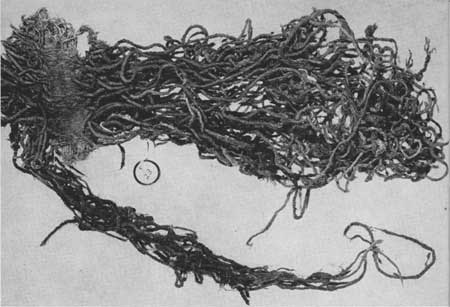
|
| Plate 36. Skirt, double fringe, Specimen No. 23 |

|
| Figure 30 |
Specimen 26. Skirt (PS No. 6, 9)
Maximum length: 8-1/4"; 21 cm.
Maximum width: 3"; 7.8 cm. Width of weave: 1-1/2". 3.8cm.
Material: Yucca baccata. Natural color of the yucca, M&P 13-J-6.
Weave: Skirt (Cf. Haury, p. 62; Specimens Nos. 23, p. 56, 40 and 49, p. 58.) The foundation is a loosely twisted bunch of yucca strands (about 27), bent double and tied at one end in a simple twist. Small twisted yucca strings are twined over and under the two units thus formed. These small strings are paired; two pairs are twisted to make the fringe (x, 1/8" wide strands). Sometimes fringes thus made will be paired off and twisted again (y). There are 44 yucca strings per inch; 22 per cm. The base units are bulky, and the weave elements are crowded close together, usually on top of each other, so that the article is very thick (1/2"; 1.2 cm.).
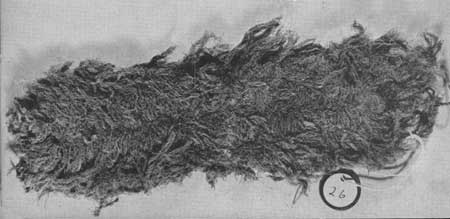
|
| Plate 37. Skirt, double fringe, Specimen No. 26 |

|
| Figure 31, Weave of Specimen 26 |
Specimen 40. Skirt
Maximum length: (Two fringes and center section) 19 3/16"; 48.7 cm.
Maximum length of fringe: 9-1/2"; 24.1 cm. Width of center section: 1-1/2"; 3.8 cm.
Maximum width: (In this case, length of center section) 5-3/4"; 14.6 cm.
Material: Yucca elata.
Weave: Skirt (Cf. Haury, p. 62; Specimens Nos. 23, p. 56, 26, p. 57, and 49, below.) Yucca strands woven over a rope composed of 22 yucca strings. This rope is doubled and the ends tied in a simple twist, so that it forms two central units. There are 12 strands per inch (6 per cm.) woven over the central units. These strands are treated as pairs, and twisted into four-strand fringes on either side of the central units. (See drawing for Specimen No. 28, p. 45.)
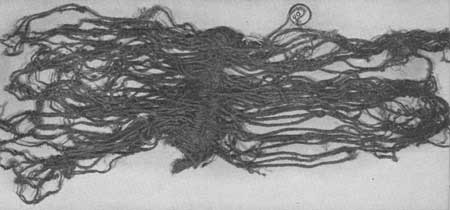
|
| Plate 38. Skirt, double fringe, Specimen No. 40 |
Specimen 49. Skirt. (PS No. 9)
Maximum length: (length of center pad) 8"; 20.4 cm.
Maximum width: (center pad and fringes) 3-1/2"; 8.9 cm. Width without fringe: 1-1/4"; 3.2 cm.
Material: Yucca baccata.
Weave: Skirt (Cf. Haury, p. 62; Specimens Nos. 23, p. 56, 26, p. 57, and 40, above). Yucca strands woven over a rope composed of 20 yucca strings, 1/16" (.2 cm.) wide. This rope is doubled and the ends are tied in a square knot, so that two center units are formed. Pairs of strands are woven over these center units, 10 pairs per inch (5 pairs per cm.). The pairs are twisted together to make four-strand fringe units. (See drawing for Specimen No. 26, p. 57.)

|
| Plate 39. Skirt, double fringe, Specimen No. 49 |
Specimen 24. Skirt. (PS No. 23)
Maximum length: 15"; 38.2 cm. There are two sections, joined together by a square knot. (See photograph.) Length of section a: 6"; 15.2 cm., to edge of knot. Length of section b: 7-3/8"; 18.8 cm., to edge of knot. Maximum width: Fringe plus woven section: 7-1/4"; 19.6 cm. Maximum length of fringe: 6-3/4"; 17.1 cm. Maximum width of woven section: 1"; 2.5 cm.
Material: Yucca baccata strands woven over cords of Agave parryi. (Our analysis and Jones' find some cotton and one hair from a small mammal mixed with the yucca. The hair was probably caught in the weave by chance.)
Weave: Skirt (Cf. Haury, p. 62, Pl. 40). The skirts Haury mentions, though in similar technique to the ones in the collection, were made of apocynum fiber.) Composed of small twisted strands of yucca fiber. Strings twined over and under three basic units of agave fiber. Twenty-four of these strings per inch; 12 per cm. Unit 1: 12 strands; unit 2: 12 strands; unit 3: 6 strands. The fringe is composed of four of the over-under strings twisted into strands 1/8"; .3 cm., wide.
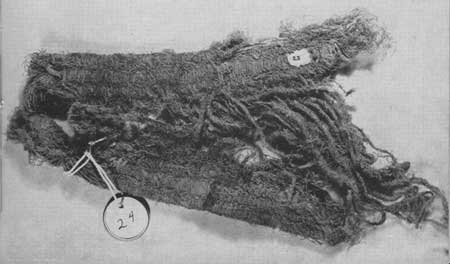
|
| Plate 40. Skirt, single fringe, Specimen No. 24 |

|
| Figure 32. Specimen 24. |
Specimen 41. Skirt (PS No. 16)
Maximum length: (fringe and waist band) 9-3/4"; 24.8 cm. Maximum length of fringe: 9"; 23 cm. Width of waist band: 3/4"; 2 cm.
Maximum width: (length of waist band) 9-3/4"; 24.8 cm.
Material: Cotton. (Jones' analysis and ours note the presence of some yucca fibers.)
Decoration: Color, M&P 13-A-9. Several long twisted strands of the same color and material appear to be sections of the fringe which have broken off, or pieces from an identical skirt. Reddish-orange color is rubbed on.
Weave: Skirt (Cf. Haury, p. 62; specimens Nos. 23, p. 56, 24, p. 59, 26, p. 57, 40 and 49, p. 58.) Waist band composed of: One cord of 14 strands, which is doubled to make the two main units of the waist band (a); One additional cord of two strands (b). Fringe: Two-ply strands twisted over the waist cords, 31 per inch, 14 per cm. (c). These strands are then twisted together to make four-strand fringe units (d). The 14-strand waist cord is fastened to a cord composed of eight tightly-twisted strings. This was probably part of a tie arrangement to fasten the skirt. (See Fig. 33, e.)
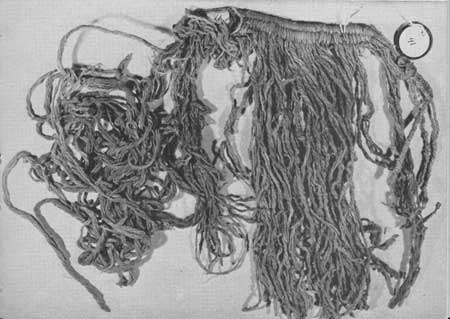
|
| Plate 41. Skirt, single fringe, Specimen No. 41 |

|
| Figure 33. Specimen 41. |
| <<< Previous | <<< Contents>>> | Next >>> |
wnpa/tech/3-2/sec3.htm
Last Updated: 04-Mar-2008
Western National Parks Association